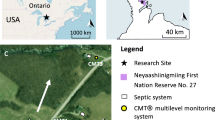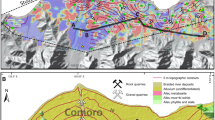Abstract
A major water quality issue in urban areas underlain by a productive aquifer is the impact of modern recharge. Using a variety of sample sources including multi-level boreholes, detectable concentrations of CFCs and SF6 have been found throughout the upper 50 m of the saturated aquifer beneath a suburb of Doncaster, UK, indicating that modern (<50-year old) recharge has penetrated to at least this depth. Additional support for this deep penetration is provided by the detection of sulphite-reducing clostridia and faecal streptococci. Despite the upper aquifer being a poorly cemented sandstone, the residence time indicators suggest that some modern recharge is travelling via fracture systems in addition to that moving down by simple piston flow. However, the overall impact of 80 years of steady urbanisation on water quality in the aquifer beneath this suburb has in general been limited. This is attributed to a combination of factors including previous land use, dilution by direct recharge of rainfall through green-space areas including gardens, and locally high storage in the friable upper aquifer.
Résumé
Une des principales problématiques de la qualité de l’eau en zone urbaine dont le sous-sol est occupé par un aquifère productif est l’impact de la recharge récente. Utilisant différentes chroniques dont un piezomètre multi niveaux, on a trouvé, dans les 50 m supérieurs de la zone saturée de l’aquifère situé sous le métro de Doncaster, UK, des concentrations détectables de CFC et de SF6 qui indiquent qu’une recharge moderne (inf. à 50 ans) a pénétré au moins à cette profondeur. Cette profondeur est aussi validée par la détection de Clostridia sulfito réductives et de Streptocoques fécaux. L’aquifère supérieur est un grès peu cimenté, les marqueurs du temps de séjour suggèrent pourtant qu’une recharge récente voyage à travers un système de fracture en plus de la recharge qui se déplace par effet piston. Toutefois, du point de vue de la qualité de l’eau de l’aquifère situé sous le métro, l’impact global de 80 années d’urbanisation constante est en général limité. Ceci est attribué à une combinaison de facteurs dont l’utilisation précédente de la terre, la dilution par la recharge directe de la pluie à travers les espaces verts notamment les jardins, et un stockage important dans l’aquifère superficiel friable.
Resumen
Un problema mayor de calidad de agua, en áreas urbanas subyacidas por un acuífero productivo, es el impacto de la recarga moderna. Usando una variedad de fuentes de muestreo, incluyendo pozos multi-nivel, se han encontrado concentraciones perceptibles de CFCs y SF6 a lo largo de los 50 m superiores del acuífero saturado, bajo un suburbio de Doncaster, Reino Unido, indicando que la recarga moderna (<50 años) ha penetrado por lo menos hasta esta profundidad. Un apoyo adicional para esta penetración profunda es proporcionado por el descubrimiento de clostridia reductora de sulfitos y estreptococo fecal. A pesar que el acuífero superior es una arenisca ligeramente cementada, los indicadores de tiempo de residencia sugieren que alguna recarga moderna esta produciéndose a través de los sistemas de fractura, además de la que se produce por flujo de pistón simple. Sin embargo, el impacto global de 80 años de urbanizacion contínua, sobre la calidad de agua del acuífero ubicado bajo este suburbio ha sido limitado en general. Esto se atribuye a una combinación de factores que incluyen el uso anterior de la tierra, la dilución por la recarga directa de lluvia a través de las áreas verdes incluyendo los jardines, y localmente un almacenamiento alto en el acuífero superior friable.














Similar content being viewed by others
References
Adams MH (1959). Bacteriophages. Interscience, London
Allen DJ, Brewerton LJ, Coleby LM, Gibbs BR, Lewis MA, Macdonald AM, Wagstaff SJ, Williams AT (1997) The physical properties of major aquifers in England and Wales. British Geological Survey Technical Report (WD/97/34). Environment Agency R&D Publication, vol 8, Keyworth, UK
Anon. (1994). The microbiology of water 1994 Part 1-Drinking water. HMSO, London
Barrett MH, Hiscock KM, Pedley S, Lerner DN, Tellam JH, French MJ (1999) Marker species for identifying urban groundwater recharge sources: a review and case study in Nottingham. UK Water Res 33:3083–3097
Brown IT, Rushton KR (1993) Modelling of the Doncaster Aquifer. School of Civil Engineering, University of Birmingham, Birmingham, UK
Buckley DK (2003) Pesticides in the Triassic Sandstone aquifer of South Yorkshire: interpretation of borehole geophysical logging. British Geological Survey Commissioned Report, CF/03/071C
Bullister JL, Weiss RF (1988) Determination of CC13F and CC12F2 in seawater and air. Deep Sea Res 35(5):839–853
Busenberg E, Plummer LN (1992) Use of chlorofluorocarbons (CC13F and CC12F2) as hydrologic tracers and age-dating tools: The alluvium and terrace system of central Oklahoma. Water Resour Res 28:2257–2283
Busenberg E, Plummer LN (2000) Dating young groundwater with sulfur hexafluoride: natural and anthropogenic sources of sulfur hexafluoride. Water Resour Res 36:3011–3030
Cronin AA, Taylor RG, Powell KL, Barrett MH, Trowsdale SA, Lerner DN (2003) Temporal variations in the depth-specific hydrochemistry and sewage-related microbiology of an urban sandstone aquifer, Nottingham, United Kingdom. Hydrogeol J 11:205–216
Cronin AA, Rueedi J, Morris BL (2005) The effectiveness of selected microbial and chemical indicators to detect sewer leakage impacts on urban groundwater quality. Proceedings of the 10th International Conference on Urban Drainage, Copenhagen, Denmark, 21–26 August 2005
Darling WG, Morris BL, Stuart ME, Gooddy DC (2005) Groundwater age indicators from public supplies tapping the Chalk aquifer of Southern England. Water Environ J 19:30–40
Eiswirth M, Hötzl H (1994) Groundwater contamination by leaky sewer systems. In: Water down under, National conference of Institution of Engineeers, Adelaide, Australia, pp 111–114, November 1994
Eiswirth M, Hötzl H, Cronin AA, Morris BL, Veselic M, Bufler R, Burn S, Dillon P (2002) Assessing and improving the sustainability of urban water resources and systems. In: Proceedings of the Image-Train Cluster Meeting Cracow, Poland. October 2002. Accessible at http://www.urbanwater.de
Foster SSD, Morris BL, Lawrence AR (1994) Effects of urbanisation on groundwater recharge. In: Proceedings of the ICE international conference on groundwater problems in urban areas, London, June 1993. Thomas Telford, London
Gaunt GD (1994) Geology of the country around Goole, Doncaster and the Isle of Axholme. British Geological Survey, London
Gleeson C, Gray N (1997) The coliform index and waterborne disease, Problems of microbial drinking water assessment, ISBN 0419 21870 X. E and FN Spon, London
Ho DT, Schlosser P, Smethie WM Jr, Simpson HJ (1998) Variability in atmospheric chlorofluorocarbons (CCl3F and CCl2F2) near a large urban area: implications for groundwater dating. Environ Sci Technol 32:2377–2382
Höhener P, Werner D, Balsiger C, Pasteris G (2002) Occurence and fate of chlorofluorocarbon plumes in groundwater. In: Thornton SF, Oswald SE (eds) Groundwater quality: natural and enhanced restoration of groundwater pollution. IAHS Publ. No. 275, pp 41–47
Jackson D, Lloyd JW (1983) Groundwater chemistry of the Birmingham Triassic Sandstone aquifer and its relation to structure. Q J Eng Geol 16:135–142
Keswick BH, Wang D, Gerba CP (1982) The use of microorganisms as groundwater tracers. Ground Water 20:142–149.
Lerner DN, Issar SI, Simmers I (1990) Recharge due to urbanisation, from ‘Groundwater Recharge, A guide to understandingand estimating natural recharge’. International Contributions to Hydrogeology, vol 8. IAH, Verlag Heinz Heise, Hannover, Germany
MacDonald AM, Darling WG, Ball DF, Oster H (2003) Identifying trends in groundwater using residence time indicators: an example from the Permian aquifer of Dumfries, Scotland. Hydrogeol J 11:504–517
Morris BL, Stuart ME, Cronin AA (2003) Assessing and improving sustainability of urban water resources and systems: AISUWRS work-package 1 background study. CR/03/052C, British Geological Survey, Keyworth, Nottingham, UK
Morris BL, Darling WG, Gooddy DC, Litvak RG, Neumann I, Nemaltseva EJ, Poddubnaia I (2005) Assessing the extent of induced leakage to an urban aquifer using environmental tracers: an example from Kyrgyzstan, Central Asia. Hydrogeol J 14(1–2):225–243
National Oceanic and Atmospheric Administration, Earth System Research Laboratory (NOAA-ESRL). (2005) Website: http://www.cmdl.noaa.gov/. Accessed 8 December
Neumann I, Hughes A (2003) Translation of the Doncaster groundwater model into the MODFLOW code. British Geological Survey Commissioned Report, CR/03/258N. 27 pp
Oster H (1994) Datierung von Grundwasser mittels FCKW: Voraussetzungen, Möglichkeiten und Grenzen (Dating groundwaters with CFCs: assumptions, possibilities and limitations)—Dissertation, Universität Heidelberg
Oster H, Sonntag C, Munnich KO (1996) Groundwater age dating with chlorofluorocarbons. Water Resour Res 37:2989
Plummer LN, Busenberg E (1999) Chlorofluorocarbons. In: Cook PG, Herczeg AL (eds) Environmental tracers in subsurface hydrology. Kluwer, Dordrecht, The Netherlands, pp 441–478
Plummer LN, Busenberg E, Bohlke JK, Nelms DL, Michel RL, Schlosser P (2001) Groundwater residence times in Shenandoah National Park, Blue Ridge Mountains, Virginia, USA: a multi-tracer approach. Chem Geol 179:93–111
Powell KL, Taylor RG, Cronin AA, Barrett MH, Pedley S, Sellwood J, Trowsdale S, Lerner DN (2003) Microbial contamination of two urban sandstone aquifers in the UK. Water Res 37:339–352
Price M, Morris B, Robertson A (1982) A study of intergranular and fissure permeability in Chalk and Permian aquifers, using double-packer injection testing. J Hydrol 54:410–423
Rueedi J, Cronin AA (2003) Construction of 5 depth specific groundwater sampling sites in Doncaster, UK. Robens Centre for Public and Environmental Health, Guildford, UK
Rueedi J, Cronin AA, Morris BL (2004) Assessing and improving sustainability of urban water resources and systems: Work-package 4: Field investigations interim report. British Geological Survey Commissioned Report, 72 pp
Santella RM, Ho DT, Schlosser P, Stute M (2003) The distribution of atmospheric SF6 near a large urban area as recorded in the vadose zone. Environ Sci Technol 37:1069–1074
Smedley PL, Brewerton LJ (1997) The natural (baseline) quality of groundwater in England and Wales. Part 2: the Triassic Sherwood Sandstone of the East Midlands and South Yorkshire. British Geological Survey Technical Report WD/97/52. BGS Keyworth, England
Standing Committee of Analysts (SCA) (1995) Methods for the isolation and identification of human enteric viruses from waters and associated materials. Methods for the examination of waters and associated materials. HMSO, London
Taylor RG, Cronin AA, Trowsdale SO, Baines OP, Barrett MH, Lerner DN (2003) Vertical groundwater flow in Permo-Triassic sediments underlying two cities in the Trent River Basin (UK). J Hydrol 284:92–113
University of Karlsruhe, Dept of Applied Geology (2005) AISUWRS—Assessing and improving the sustainability of urban water resources and systems, Website http://www.urbanwater.de. Accessed 8 December
Van Ryneveld MB, Fourie AB (1997) A strategy for evaluating the environmental impact of on-site sanitation systems. Water SA 23:279–291
Wilson GB, Andrews JN, Bath AH (1994) The nitrogen isotope composition of groundwater nitrates from the East Midlands Triassic Sandstone aquifer, England. J Hydrol 157:35–46
Yates MV, Gerba CP, Kelley LM (1985) Virus persistence in groundwater. Appl Environ Microbiol 49:778–781
Acknowledgements
The authors gratefully acknowledge the assistance of our UK project stakeholders Yorkshire Water Plc., the Environment Agency and Doncaster Metropolitan Borough Council with data and discussion. Funding for this project was provided via the UK Natural Environment Research Council and the European Union 5th Framework Directive (Grant # EVK1-CT-2002-00100). Our colleagues Ilka Neumann, Jenny Cunningham, Debbie Allen, Sarah Hannay and Barry Townsend provided helpful comments, data, field sampling and analytical expertise. This paper is published with the permission of the Executive Director, British Geological Survey (NERC).
Author information
Authors and Affiliations
Corresponding author
Rights and permissions
About this article
Cite this article
Morris, B.L., Darling, W.G., Cronin, A.A. et al. Assessing the impact of modern recharge on a sandstone aquifer beneath a suburb of Doncaster, UK. Hydrogeol J 14, 979–997 (2006). https://doi.org/10.1007/s10040-006-0028-1
Received:
Accepted:
Published:
Issue Date:
DOI: https://doi.org/10.1007/s10040-006-0028-1




